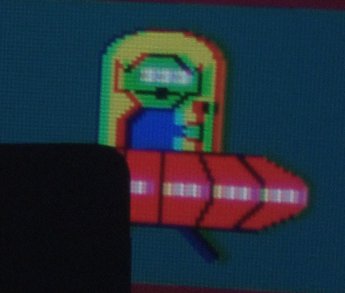Has anyone obtained an Optoma UHD50X projector yet? It's a 4K DLP projector with a 240Hz 1080p mode!
_________________
Technologically:
I'd love to compare 1080p 60Hz versus 1080p 120Hz versus 1080p 240Hz with TestUFO Photo Test.
Motion will probably look super-smooth, with a slightly amplified banding effect (compared to 60Hz) caused by reduced bits-per-refresh effects of the DLP temporal dithering. It's kind of a tradeoff effect that occurs.
Basically, the motion blurring will be reduced, but other kinds of artifacts become slightly more visible -- depending on its temporal dithering algorithm (motion compensated or non-motion-compensated), including
-- potential microrainbow artifacts in single-pixelwidth details that is no longer hidden by as much as motion blur
-- potential contouring artifacts (similiar to old plasmas).
Many algorithms by many parties exist to mitigate this to some extent (but not fully).
This is because most single-chip DLPs tend to run at ~1440Hz monochome 1bit temporally generating 24bits (1440/60Hz = 24-bits). 1440/60 = 24-bits per refresh cycles, but 1440/240 = 6-bits per refresh cycles (2 bits per color channel). This varies from DLP implementation to implementation, but the moral of the story is that the pixel pulse rate is not quadrupled at the quadrupled Hz, creating some interesting artifacts worth scientific study. Many people miss them (like many miss 3:2 pulldown detection or miss rainbow artifacts) until they notice, then they notice the artifacts.
There are some necessary compromises in temporal dithering algorithms during fast full-framerate motion (without eye tracking sensors + motion compensated temporal dithering + eye tracking compensated temporal dithering algorithms).
Static imagery will look great (no bitdepth decimation), motion will look better, but never as good as a sample-and-hold 240Hz (full color depth) because of bitdepth decimation per Hz. Blur Busters mainly works on full-color-depth-per-Hz displays nowadays, but I also study the science of display artifacts, so I'm less interested in DLP as an enabler of ultra-Hz displays because of my artifact discoveries.
That said, I'm excited that Optoma has included 240Hz modes in their DLP projector -- this is much needed progress.
As a display researcher highly experienced in display motion artifacts, I'm quite interested to see how well Optoma has done 240Hz temporally with a single-chip (for both fixed-gaze-on-moving-motion situation, as well as trakcing-gaze-on-moving-motion situations).
If you have an Optoma UHD50X, I have a question:
I'm especially interested to see what www.testufo.com/photo looks like with 1080p 60Hz, 1080p 120Hz, and 1080p 240Hz? Such as banding or contouring artifacts in the sky (compared to the reference image: paused photo which should show no banding or contouring). See what advanced algorithms Optoma included to compensate, and how good a job they are doing.
______
<Display Science>
Supplemental info: Long term, it would be neat to use four different 1440Hz DLP chips (with concurrent rainbow wheels) to get 240Hz with the same color-depth-per-Hz (24 bits) as single-chip 60Hz. Even so, the 1-bitness of DLPs generate some difficulties with the Vicious Cycle Effect, given increased resolution, increased DPI, and increased refresh rates -- amplifying visibility of refresh rate limitations. This, IMHO, will collide very hard with the per-pixel-Hz limitations of DLP for ultrafast-motion gaming (at least when compared to a good 1ms GtG 240Hz+ monitor). Though, the big screen size and color quality of a good DLP is impeccable!
Over the years, I correctly predicted some display artifacts -- of a variety of display technologies including DLP -- that many other people disbelieved in (important for businesses to put correctly fair valuations on refresh rate innovations), so this is a artifact-science that I am especially interested in. I might purchase this Optoma projector as an upgrade for my home theater, so I'll possibly get to experience some of these artifact-quirks personally myself.
Although I have not been working on any DLP projects for the last while -- some of you may have seen my recent non-DLP collaborations NVIDIA (TestUFO for the 360Hz monitor) and ViewSonic (the Blur Busters Approved programme). Displays have very interesting interactions (whether it's a Hz-raising, or a BFI-enabling, or other innovation -- for example, OLED and IPS don't degrade noticeably with BFI, while TN and DLP tends to degrade with BFI) that few people other than me understand well. It's like physics versus geometry, and BlurBusters approaches displays in ways that aren't reliably predicted by math or scientific papers or 10% measurement cutoffs -- like the strobed red phosphor situation or the stroboscopic artifacts situation.
For the last nearly ten years, Blur Busters, name sake, I'm always interested in artifact-science as I'm classically a very good predictor of artifacts that even NVIDIA consults me from time to time for my Display Einstein brain matter. So I want to study these DLP artifacts in deeper detail. I frequently surprise manufacturers.
</Display Science>
Nontheless, great seeing the refresh rate race arriving to consumer DLP projectors. Very sorely needed!


